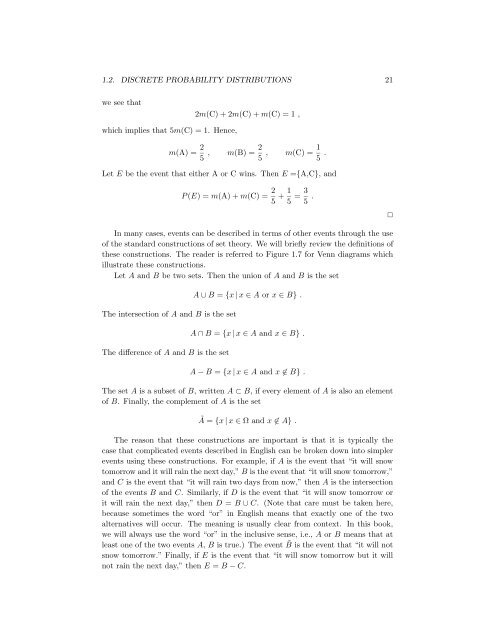Chapter 1 Discrete Probability Distributions - DIM
Chapter 1 Discrete Probability Distributions - DIM
Chapter 1 Discrete Probability Distributions - DIM
- No tags were found...
You also want an ePaper? Increase the reach of your titles
YUMPU automatically turns print PDFs into web optimized ePapers that Google loves.
1.2. DISCRETE PROBABILITY DISTRIBUTIONS 21we see that2m(C)+2m(C) + m(C)=1,which implies that 5m(C) = 1. Hence,m(A) = 2 5 , m(B) = 2 5 , m(C) = 1 5 .Let E be the event that either A or C wins. Then E ={A,C}, andP (E) =m(A) + m(C) = 2 5 + 1 5 = 3 5 .In many cases, events can be described in terms of other events through the useof the standard constructions of set theory. We will briefly review the definitions ofthese constructions. The reader is referred to Figure 1.7 for Venn diagrams whichillustrate these constructions.Let A and B be two sets. Then the union of A and B is the setThe intersection of A and B is the setThe difference of A and B is the setA ∪ B = {x | x ∈ A or x ∈ B} .A ∩ B = {x | x ∈ A and x ∈ B} .A − B = {x | x ∈ A and x ∉ B} .The set A is a subset of B, written A ⊂ B, if every element of A is also an elementof B. Finally, the complement of A is the setà = {x | x ∈ Ω and x ∉ A} .The reason that these constructions are important is that it is typically thecase that complicated events described in English can be broken down into simplerevents using these constructions. For example, if A is the event that “it will snowtomorrow and it will rain the next day,” B is the event that “it will snow tomorrow,”and C is the event that “it will rain two days from now,” then A is the intersectionof the events B and C. Similarly, if D is the event that “it will snow tomorrow orit will rain the next day,” then D = B ∪ C. (Note that care must be taken here,because sometimes the word “or” in English means that exactly one of the twoalternatives will occur. The meaning is usually clear from context. In this book,we will always use the word “or” in the inclusive sense, i.e., A or B means that atleast one of the two events A, B is true.) The event ˜B is the event that “it will notsnow tomorrow.” Finally, if E is the event that “it will snow tomorrow but it willnot rain the next day,” then E = B − C.✷
















